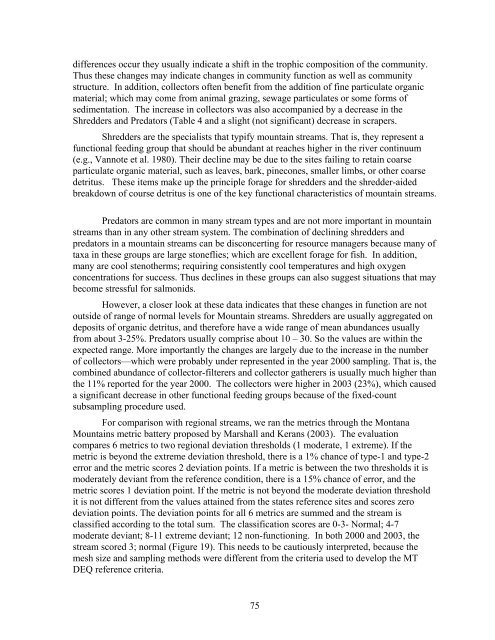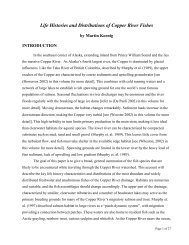Mitigation for the Construction and Operation of Libby Dam
Mitigation for the Construction and Operation of Libby Dam
Mitigation for the Construction and Operation of Libby Dam
You also want an ePaper? Increase the reach of your titles
YUMPU automatically turns print PDFs into web optimized ePapers that Google loves.
differences occur <strong>the</strong>y usually indicate a shift in <strong>the</strong> trophic composition <strong>of</strong> <strong>the</strong> community.<br />
Thus <strong>the</strong>se changes may indicate changes in community function as well as community<br />
structure. In addition, collectors <strong>of</strong>ten benefit from <strong>the</strong> addition <strong>of</strong> fine particulate organic<br />
material; which may come from animal grazing, sewage particulates or some <strong>for</strong>ms <strong>of</strong><br />
sedimentation. The increase in collectors was also accompanied by a decrease in <strong>the</strong><br />
Shredders <strong>and</strong> Predators (Table 4 <strong>and</strong> a slight (not significant) decrease in scrapers.<br />
Shredders are <strong>the</strong> specialists that typify mountain streams. That is, <strong>the</strong>y represent a<br />
functional feeding group that should be abundant at reaches higher in <strong>the</strong> river continuum<br />
(e.g., Vannote et al. 1980). Their decline may be due to <strong>the</strong> sites failing to retain coarse<br />
particulate organic material, such as leaves, bark, pinecones, smaller limbs, or o<strong>the</strong>r coarse<br />
detritus. These items make up <strong>the</strong> principle <strong>for</strong>age <strong>for</strong> shredders <strong>and</strong> <strong>the</strong> shredder-aided<br />
breakdown <strong>of</strong> course detritus is one <strong>of</strong> <strong>the</strong> key functional characteristics <strong>of</strong> mountain streams.<br />
Predators are common in many stream types <strong>and</strong> are not more important in mountain<br />
streams than in any o<strong>the</strong>r stream system. The combination <strong>of</strong> declining shredders <strong>and</strong><br />
predators in a mountain streams can be disconcerting <strong>for</strong> resource managers because many <strong>of</strong><br />
taxa in <strong>the</strong>se groups are large stoneflies; which are excellent <strong>for</strong>age <strong>for</strong> fish. In addition,<br />
many are cool steno<strong>the</strong>rms; requiring consistently cool temperatures <strong>and</strong> high oxygen<br />
concentrations <strong>for</strong> success. Thus declines in <strong>the</strong>se groups can also suggest situations that may<br />
become stressful <strong>for</strong> salmonids.<br />
However, a closer look at <strong>the</strong>se data indicates that <strong>the</strong>se changes in function are not<br />
outside <strong>of</strong> range <strong>of</strong> normal levels <strong>for</strong> Mountain streams. Shredders are usually aggregated on<br />
deposits <strong>of</strong> organic detritus, <strong>and</strong> <strong>the</strong>re<strong>for</strong>e have a wide range <strong>of</strong> mean abundances usually<br />
from about 3-25%. Predators usually comprise about 10 – 30. So <strong>the</strong> values are within <strong>the</strong><br />
expected range. More importantly <strong>the</strong> changes are largely due to <strong>the</strong> increase in <strong>the</strong> number<br />
<strong>of</strong> collectors—which were probably under represented in <strong>the</strong> year 2000 sampling. That is, <strong>the</strong><br />
combined abundance <strong>of</strong> collector-filterers <strong>and</strong> collector ga<strong>the</strong>rers is usually much higher than<br />
<strong>the</strong> 11% reported <strong>for</strong> <strong>the</strong> year 2000. The collectors were higher in 2003 (23%), which caused<br />
a significant decrease in o<strong>the</strong>r functional feeding groups because <strong>of</strong> <strong>the</strong> fixed-count<br />
subsampling procedure used.<br />
For comparison with regional streams, we ran <strong>the</strong> metrics through <strong>the</strong> Montana<br />
Mountains metric battery proposed by Marshall <strong>and</strong> Kerans (2003). The evaluation<br />
compares 6 metrics to two regional deviation thresholds (1 moderate, 1 extreme). If <strong>the</strong><br />
metric is beyond <strong>the</strong> extreme deviation threshold, <strong>the</strong>re is a 1% chance <strong>of</strong> type-1 <strong>and</strong> type-2<br />
error <strong>and</strong> <strong>the</strong> metric scores 2 deviation points. If a metric is between <strong>the</strong> two thresholds it is<br />
moderately deviant from <strong>the</strong> reference condition, <strong>the</strong>re is a 15% chance <strong>of</strong> error, <strong>and</strong> <strong>the</strong><br />
metric scores 1 deviation point. If <strong>the</strong> metric is not beyond <strong>the</strong> moderate deviation threshold<br />
it is not different from <strong>the</strong> values attained from <strong>the</strong> states reference sites <strong>and</strong> scores zero<br />
deviation points. The deviation points <strong>for</strong> all 6 metrics are summed <strong>and</strong> <strong>the</strong> stream is<br />
classified according to <strong>the</strong> total sum. The classification scores are 0-3- Normal; 4-7<br />
moderate deviant; 8-11 extreme deviant; 12 non-functioning. In both 2000 <strong>and</strong> 2003, <strong>the</strong><br />
stream scored 3; normal (Figure 19). This needs to be cautiously interpreted, because <strong>the</strong><br />
mesh size <strong>and</strong> sampling methods were different from <strong>the</strong> criteria used to develop <strong>the</strong> MT<br />
DEQ reference criteria.<br />
75
















